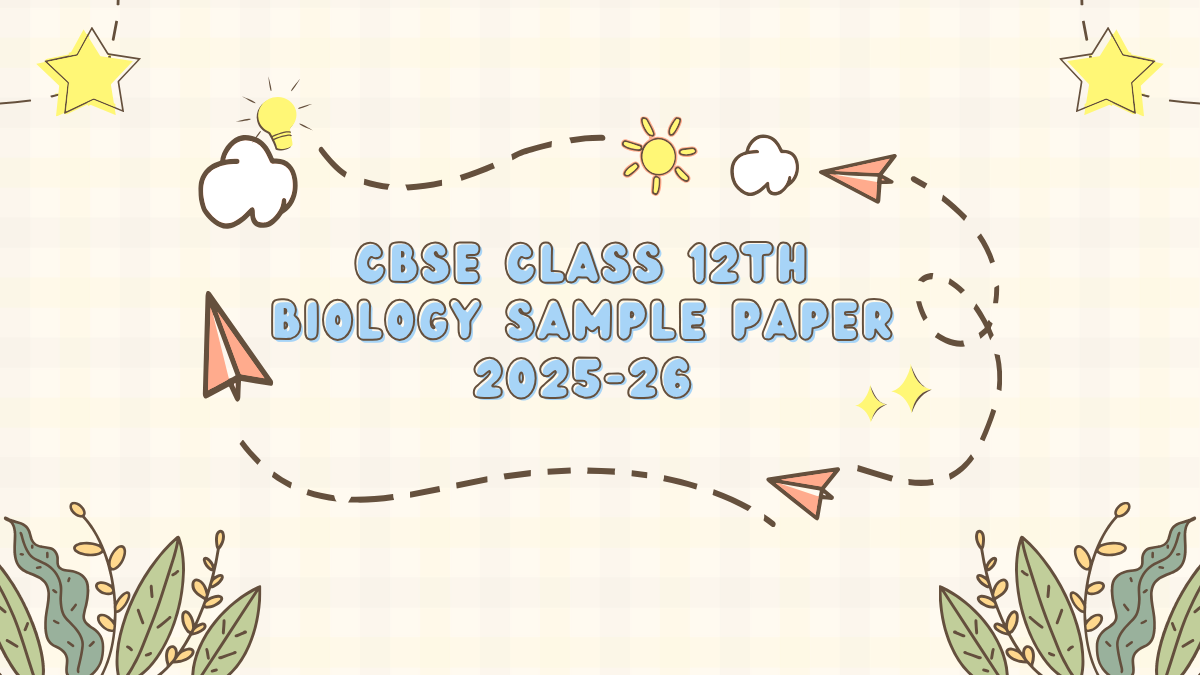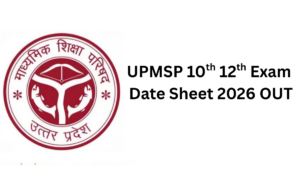The CBSE Class 12 Sample paper for all subjects has been released by the board for the academic year 2025-26 on its academic portal. These CBSE Class 12 Biology Sample Papers 2025-26 are an important tool for students preparing for midterm exams.
These are useful tools for students to check their understanding of subjects, familiarise themselves with the final exam structure, highlight important themes, and become acquainted with probable question styles. Students can readily access and download the CBSE Class 12th biology Sample paper 2025-26 PDF with solutions from here, which is an excellent resource for self-assessment and revision.
CBSE Class 12 Biology Sample Paper 2025-26 PDF Download
The CBSE class 12 Biology sample paper 2025-26, along with the official solutions and marking scheme, is available below in PDF format. Download the CBSE Class 12th Biology Sample Paper 2025-26 with Solutions PDF and use it to perform well on the upcoming intermediate board exam.
| CBSE Class 12th Biology Sample Paper PDF download | |
| CBSE Class 12 Biology Sample Paper 2025-26 PDF Download | Click here to download |
| CBSE Class 12th Biology Sample Paper Solutions | Download now |
Class 12th Biology Sample Paper Pattern
Before moving to the Class 12th Biology Sample paper with solution analysis, let’s take a quick look at the paper pattern at a glance for better understanding.
- Total Marks allotted for Class 12th Biology Exam: 70 Time: 3 hours
- Duration of the Class 12th Exa, : 3 hours
- All questions are compulsory.
- The question paper has five sections and 33 questions.
- The sample paper is divided into five sections as follows
- Section A has 16 questions of 1 mark each;
- Section B has 5 questions of 2 marks each.
- Section C has 7 questions of 3 marks each.
- Section D has 2 case-based questions of 4 marks each
- Section–E has 3 questions of 5 marks each.
- There is no overall choice. Answer all 33 questions. However, internal choices
have been provided in some questions. A student has to attempt only one of the
alternatives in such questions. - Whenever necessary, neat and properly labeled diagrams should be drawn.
CBSE Class 12th Biology Sample Paper 2025-26 with Solutions
1 The male gametes are formed by:
A. Mitotic division of the nucleus of the vegetative cell
B. Meiotic division of the nucleus of the vegetative cell
C. Mitotic division of the nucleus of the generative cell
D. Meiotic division of the nucleus of the generative cell
2 The primary endosperm nucleus is formed by the fusion of which of the
following?
A. A male gamete and a female gamete
B. A male gamete and two polar nuclei
C. A female gamete and two synergids
D. Two male gametes and an egg cell
3 During the menstrual cycle of a human female, formation of the Graafian follicle is stimulated by the secretion of which of the following gonadotropin hormones?
A. Estrogen and progesterone
B. FSH and Estrogen
C. FSH and LH
D. Progesterone and LH
4. The experimental proof on the thermal stability of genetic material was first provided by experiments of
A. Hershey and Chase
B. Meselson and Stahl
C. Frederick Griffith
D. Jacob and Monod
5. Short stretches of DNA are used to identify complementary sequences in a
Samples are called
A. Probes
B. Markers
C. Primers
D. Minisatellites
6 Select the incorrect statement among the following.
A. p²+2pq+q² = 1. This is the binomial expansion of (p+q)²
B. When the frequency measured differs from the expected values, the difference (direction) indicates the extent of evolutionary change.
C. Hardy-Weinberg principle says that phenotype frequencies in a population are stable and are constant from generation to generation.
D. The gene pool (total genes and their alleles in a population) remains constant. This is called genetic equilibrium. The total of all the allelic frequencies is 1.
7. Albinism is known to be due to an autosomal recessive mutation. The first child of a couple with normal skin pigmentation was an albino. What is the probability that their second child will also be an albino?
A. 100%
B. 25%
C. 50%
D. 75%
8 “In Cricket species, the sound produced by rubbing the wings or legs together plays a crucial role in attracting mates; any change in the morphology of Cricket legs could potentially affect their ability to produce sound”.
A mutant Cricket had thicker hind legs. What would you expect for this cricket species?
A. The leg mutation will not lead to speciation if they diversify into new habitats.
B. The leg mutation will have little effect on other external features, and therefore have little effect on speciation.
C. The leg mutation will not affect behavior, and thus has little effect on speciation.
D. The leg mutation might lead to reproductive isolation and speciation due to an effect on the mating call.
9. Plasmodium is a pathogen that causes malaria. Identify the correct sequence of transmission of the pathogen.
 10. Which mRNA will be translated to a polypeptide chain containing 8 amino acids?
10. Which mRNA will be translated to a polypeptide chain containing 8 amino acids?
A. AUGUUAAUAGACGAGUAGCGACGAUGU
B. AUGAGACGGACUGCAUUCCCAACCUGA
C. AUGCCCAACCGUUAUUCAUGCUAG
D. AUGUCGACAGUCUAAAACAGCGGG
11 To isolate the genetic material of a bacterium, the cell must be treated
with
A. Lysozyme, ribonuclease, protease, chilled ethanol
B. Cellulase, ribonuclease, protease, chilled ethanol
C. Chitinase, ribonuclease, chilled ethanol, water
D. Ribonuclease, protease, chilled ethanol, water
12 Integrated Pest Management involves
I. Using pesticides/insecticides judiciously
II. Using biocontrol agents
III. Engaging in organic farming
A. Only I
B. Only II
C. Both I and II
D. Only III
Questions No. 13 to 16 consist of two statements – Assertion (A) and Reason (R). Answer these questions by selecting the appropriate option given below:
A. Both A and R are true, and R is the correct explanation of A.
B. Both A and R are true, and R is not the correct explanation of A.
C. A is tr, but R is false.
D. A is Fa,lsut R is true.
13 Assertion (A): The ability of the pistil to recognise the pollen is the result of a continuous dialogue between pollen and pistil.
Reason (R): This electrical dialogue allows only compatible pollen to germinate.
14 Assertion (A): Some organisms are better adapted to survive in an otherwise hostile environment.
Reason (R): Adaptive ability is inherited and has a genetic basis.
15 Assertion (A): Excess dose of coke or crack produces a sense of
euphoria, increased energy, and causes hallucinations.
Reason(R): It interferes with the transport of dopamine
16 Assertion (A): Rosie was the first transgenic cow to make more nutritionally balanced milk for consumption by human babies.
Reason (R): The milk of Rosie’s cow contained human beta-lactalbumin, which made the milk rich in protein.
Advantages of Solving the CBSE 12 Class Biology Sample Paper 2025-26
The CBSE Class XII Biology Sample Paper 2025-26 is published by an expert in the field and provides students with an understanding of the latest syllabus and guidance. The sample is also representative of the likely difficulty of the “real exam” and will be practiced in line with the board CBSE. The advantages to students are:
Familiarity with New Examination Format – working through the CBSE biology board exam sample paper will provide students with an idea of the “real exam” structure, types of questions, and mark distribution.
Time Management – practicing in exam conditions simulates the pressure of managing the time constraints of 3 hours.
Answer Development – the mark allocation guide illustrates how marks are awarded when developing a response, which is useful, by clarifying how students can develop their style to gain the highest marks possible.
Self-Identifying Weakness – self-assessing their practice after each practice will permit students to note what topics need further revision.
Reduced Anxiety Level – Knowing what the paper looks like before the exam period will assist students with anxiety alleviation and confidence.










 CUET PG Geography Syllabus 2026, Check I...
CUET PG Geography Syllabus 2026, Check I...
 CUET PG Hindi Syllabus 2026, Download CU...
CUET PG Hindi Syllabus 2026, Download CU...
 UP Board Time Table 2026 Updated, Check ...
UP Board Time Table 2026 Updated, Check ...








